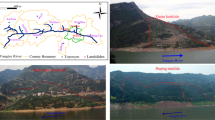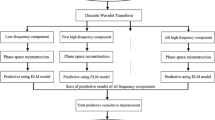Abstract
This study aimed to propose a new forecast combination method for landslide displacement based on the monitoring dataset. Considering the existence of outlier data, the 3σ method was used to eliminate them firstly. In order to diminish the effect of different length units, Z-score normalization was employed in this paper. Space reconstruction was performed to calculate the Lyapunov exponent, which was to verify whether the time series were chaotic. Three models were further studied here, namely, adding-weight one-rank local-region prediction method, adding-weight zero-rank local-region prediction method, and the largest Lyapunov exponent method. Furthermore, they are compared with respect to accuracy with each other and measured data so as to establish a forecast combination method. In order to check its validity, this method was applied to the analysis of the dataset of a 434-day displacement monitoring project performed on 12 monitoring points distributed on 4 profile maps on Qinghuasi Landslide Treatment Project in Yan’an, China. This model, which was not only implemented on a single point but also extended some results to a profile map, effectively, predicted the slope deformation in Qinghuasi landslide site. Prediction results indicate that the displacement of A-A profile map is relatively minimal, while slope deformation has been significant on the whole profile map of C-C. Situations at B-B and D-D are better than C-C profile map, though local failures have occurred at these two profile maps. This new model achieved a higher accuracy. Engineering measures based on these predicting results work effectively, which shows that it would be helpful in practical applications. This paper provides new idea and calculating method that can be used to develop deep data-mining approaches for landslide displacement prediction.






Similar content being viewed by others
References
Al-Anazi A, Gates ID (2010) A support vector machine algorithm to classify lithofacies and model permeability in heterogeneous reservoirs. Eng Geol 114(3-4):267–277. https://doi.org/10.1016/j.enggeo.2010.05.005
Cai Z, Xu W, Meng Y, Shi C, Wang R (2016) Prediction of landslide displacement based on ga-lssvm with multiple factors. Bull Eng Geol Environ 75(2):637–646. https://doi.org/10.1007/s10064-015-0804-z
Chen H, Zeng Z (2013) Deformation prediction of landslide based on improved back-propagation neural network. Cogn Comput 5(1):56–62. https://doi.org/10.1007/s12559-012-9148-1
Chen W, Xiao X, Zhang J (2012) Application of fuzzy least squares support vector machines in landslide deformation prediction. Adv Mater Res 594-597:2402–2405. https://doi.org/10.4028/www.scientific.net/amr.594-597.2402
Clemen RT (1989) Combining forecasts: a review and annotated bibliography. Int J Forecast 5(4):559–583. https://doi.org/10.1016/0169-2070(89)90012-5
Gao W, Dai S, Chen X (2020) Landslide prediction based on a combination intelligent method using the gm and enn: two cases of landslides in the three gorges reservoir, china. Landslides 17(1):111–126. https://doi.org/10.1007/s10346-019-01273-w
Guerra JA, Murray SA, Bloomfield DS et al (2020) Ensemble forecasting of major solar flares: methods for combining models. J Space Weather Space Clim 10:17. https://doi.org/10.1051/swsc/2020042
Huang F, Yin K, Zhang G, Gui L, Yang B, Liu L (2016) Landslide displacement prediction using discrete wavelet transform and extreme learning machine based on chaos theory. Environ Earth Sci 75(20):18. https://doi.org/10.1007/s12665-016-6133-0
Kil R, Park H, Kim S (1999) Time series analysis based on the smoothness measure of mapping in the phase space of attractors. IJCNN’99. International Joint Conference on Neural Networks. Proceedings (Cat. No.99CH36339). https://doi.org/10.1109/ijcnn.1999.833482
Li X, Kong J, Wang Z (2011) Landslide displacement prediction based on combining method with optimal weight. Nat Hazards 61(2):635–646. https://doi.org/10.1007/s11069-011-0051-y
Li Y, Sun R, Yin K, Xu Y, Chai B, Xiao L (2019) Forecasting of landslide displacements using a chaos theory based wavelet analysis-volterra filter model. Sci Rep 9:19. https://doi.org/10.1038/s41598-019-56405-y
Li X, Xu R, Yang W, Li P, Yang K, Zhang W (2020) Experimental study on distribution of landslide thrust in pile-anchor structure based on photoelastic technique. Materials 13(6):1358. https://doi.org/10.3390/ma13061358
Liu Y, Zhang Y (2014) Application of optimized parameters SVM in deformation prediction of creep landslide tunnel. Appl Mech Mater 675-677:265–268. https://doi.org/10.4028/www.scientific.net/amm.675-677.265
Miao S, Hao X, Guo X, Wang Z, Liang M (2017) Displacement and landslide forecast based on an improved version of Saito’s method together with the Verhulst-Grey model. Arab J Geosci 10:53. https://doi.org/10.1007/s12517-017-2838-y
Peng J, Wang S, Wang Q, Zhuang J, Huang W, Zhu X, Leng Y, Ma P (2019) Distribution and genetic types of loess landslides in China. J Asian Earth Sci 170:329–350. https://doi.org/10.1016/j.jseaes.2018.11.015
Qin S, Jui J, Wang S et al (2001) A nonlinear catastrophe model of instability of planar-slip slope and chaotic dynamical mechanisms of its evolutionary process. Int J Solids Struct 38(44-45):8093–8109. https://doi.org/10.1016/s0020-7683(01)00060-9
Rosenstein MT, Collins JJ, De Luca CJ (1993) A practical method for calculating largest Lyapunov exponents from small data sets. Physica D: Nonlinear Phenomena 65(1-2):117–134. https://doi.org/10.1016/0167-2789(93)90009-p
Wang F, Yuan J, Zu W et al (2012a) Transformer vibration signal trend prediction based on EMD and adding-weight one-rank local-region method. Electron Sci Technol 25(8):62–66
Wang J, Lu H, Dong Y, Chi D (2012b) The model of chaotic sequences based on adaptive particle swarm optimization arithmetic combined with seasonal term. Appl Math Model 36(3):1184–1196. https://doi.org/10.1016/j.apm.2011.07.089
White EM, Dattero R, Flores B (1992) Combining vector forecasts to predict thoroughbred horse race outcomes. Int J Forecast 8(4):595–611. https://doi.org/10.1016/0169-2070(92)90069-l
Xia X, Lv T, Meng F (2010) Gray chaos evaluation model for prediction of rolling bearing friction torque. J Test Eval 38(3):291–300. https://doi.org/10.1520/jte102623
Xie S, Liang Y, Zheng Z, Liu H (2017) Combined forecasting method of landslide deformation based on meemd, approximate entropy, and wls-svm. ISPRS Int J Geo Inf 6(1). https://doi.org/10.3390/ijgi6010005
Xu R, Li X, Yang W, Jiang C, Rabiei M (2019) Use of local plants for ecological restoration and slope stability: a possible application in Yan’an, Loess Plateau, China. Geomat Nat Haz Risk 10(1):2106–2128. https://doi.org/10.1080/19475705.2019.1679891
Yang W, Li C, Xu R, Li X (2020) Experimental investigation on time-frequency characteristics of microseismic signals in the damage evolution process of coal and rock. Energies 13(4):809. https://doi.org/10.3390/en13040809
Zhang HR, Yang Y, Zhang Y et al (2020a) A combined model based on ssa, neural networks, and lssvm for short-term electric load and price forecasting. Neural Comput Applic 16. https://doi.org/10.1007/s00521-020-05113-0
Zhang L, Shi B, Zhu HH, Yu XB, Han H, Fan X (2020b) Pso-svm-based deep displacement prediction of majiagou landslide considering the deformation hysteresis effect. Landslides 15. https://doi.org/10.1007/s10346-020-01426-2
Funding
This work was supported by the Fundamental Research Funds for the Central Universities (No. 310826171013, 310826172203), Team of College Students’ Summer Holiday Social Practices, Provincial university student innovation and entrepreneurship training programs (No. S202010710420, S202010710433), Natural Science Basic Research Plan in Shaanxi Province of China (No. 2018JQ4044), Shaanxi Science & Technology Co-ordination & Innovation Project (2016KTZDSF04-05-04), Shaanxi Key R&D Plan (No. 2017ZDXM-SF-082) and Shaanxi Key Science and Technology Innovation Team Project (No. 2016KCT-13). The award of a China Scholarship Council (CSC) Visiting Scholar grant to Rui Xu (No. 201706565054) supported the development of this paper.
Author information
Authors and Affiliations
Corresponding authors
Additional information
Responsible Editor: Amjad Kallel
Rights and permissions
About this article
Cite this article
Li, X., Jiang, C., Xu, R. et al. Combining forecast of landslide displacement based on chaos theory. Arab J Geosci 14, 202 (2021). https://doi.org/10.1007/s12517-021-06514-8
Received:
Accepted:
Published:
DOI: https://doi.org/10.1007/s12517-021-06514-8




